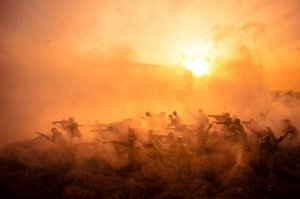What's an Insurgency?

Many people are confused by the term “insurgency”. For example, is the Islamic State an insurgency group or a terrorist group? It’s not an easy question to answer due to all the changes this group has undergone over the years. Nevertheless, to be able to call something an “insurgency”, you first have to know exactly what it means.
It might be helpful to list some groups that experts have considered insurgencies before talking about the definition. Some of the most well-known names in this category are the Islamic State, Al Qaeda, and Boko Haram. Others are the FARC, the Taliban, Hezbollah, Hamas, the ETA, and the IRA. Although some of these have fallen by the wayside, experts have considered all of them insurgent groups at one point or another.

Defining insurgency
Finding a simple and precise definition for insurgency is a difficult task. Nevertheless, we can highlight some points of commonality that different definitions of the word have. Basically, you can say that an “insurgency” is actions a minority group within a state takes in order to force political change. So, at the very least, it has political objectives.
By the same token, insurgencies make use of propaganda or military pressure in order to persuade or intimidate a population. Their goal is to gain popular support. As such, their recognition and acceptance by the population at large is pivotal and essential to their success or failure.
Finally, an insurgency also has the quality of inequality in terms of forces. Given that the state tends to have much more power, insurgent groups prefer asymmetric and prolonged encounters with the government. As such, psychological warfare tends to become their primary tool.
“Like a wild animal, the truth is too powerful to remain caged.”
-Veronica Roth-
How people start and consolidate an insurgency
In order for an insurgency to be created, the following factors have to be present:
- A politically relevant identity. The rebels need to make their identity stand out. It needs to be so strong, in fact, that people should be willing to fight to defend it.
- An attractive cause. There needs to be some wrong that the majority of the population needs to be interested in correcting.
- Popular support. If the rebels can obtain the following factors, they’re more likely to achieve this, too.
- Strong leadership. Leadership lends a group cohesion, coordination, and credibility.
- Power beyond that of rival groups. Being stronger than the other groups or even just being able to cooperate with them can be a determining factor as to whether the insurgency gains traction.
- A place of refuge. Sanctuaries or refuges can ensure the survival of the insurgency.
- The ability to secure external support. Support from outside states may be essential.
- The ability to discern mistakes that the political authorities may make. A bad move made by the state can bring a group more support from the population for the insurgency.
Classification of insurgencies
Generally, experts divide insurgencies into one of two groups: national insurgencies and those seeking freedom. In national insurgencies, the rebels are opposed to a certain government on ideological, ethnic, economic, or other grounds. In liberation insurgencies, they’re facing a regime that’s supported or controlled by foreigner influences.
Aside from this, there are other possible classifications. Some people also classify them along the lines of their goals.
You can divide goal-based insurgency classification into three types:
- Power and political projection. Groups with these goals try to take control of the state to install a new regime.
- Political power and territory. In this case, the groups seek to throw out a foreign occupier or, in other words, gain national independence.
- Local or tribal autonomy in order to maintain or gain freedom from state control. These groups seek to undermine the governing authority in a state that’s partially or totally failed. Their end goal is to eventually take control of the government.

The five pillars of insurgent activity
Insurgents can make use of five strategic instruments in order to reach their goals. The list is as follows: armed struggle, propaganda, social aid, social and political activism, and the cultivation of external relations.
- Armed struggle. The use of violence is common in insurrections. The tactics they most heavily use are guerilla warfare and, in a supporting role, terrorism.
- Propaganda. Through the use of propaganda, insurgent groups seek to win over the hearts of people. They target both the domestic and international population with this tactic.
- Social aid. Social aid aims to gather support from the population and to mobilize it.
- Social and political activism. They create or infiltrate civic associations, unions, and perhaps even political parties.
- External relations: Support from the international community is a great advantage. Many insurrections try to secure it.
As you might be able to deduce from this outline, insurgencies strongly resemble the products of other violent groups who make use of terrorism and guerrilla warfare. Telling them apart isn’t easy. Nevertheless, the factors that set the stage for them, as well as those that lead to their success, are clear.
All cited sources were thoroughly reviewed by our team to ensure their quality, reliability, currency, and validity. The bibliography of this article was considered reliable and of academic or scientific accuracy.
- Guindo, M. G. (2013). Insurgencia y contrainsurgencia. In J. Jordán (Ed.), Manual de Estudios Estratégicos y Seguridad Internacional (pp. 15–43). Madrid: Plaza y Valdés.
This text is provided for informational purposes only and does not replace consultation with a professional. If in doubt, consult your specialist.








